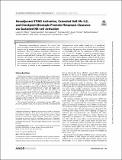| dc.contributor.author | Milling, Lauren E | |
| dc.contributor.author | Garafola, Daniel | |
| dc.contributor.author | Agarwal, Yash | |
| dc.contributor.author | Wu, Shengwei | |
| dc.contributor.author | Thomas, Ayush | |
| dc.contributor.author | Donahue, Nathan | |
| dc.contributor.author | Adams, Josetta | |
| dc.contributor.author | Thai, Nikki | |
| dc.contributor.author | Suh, Heikyung | |
| dc.contributor.author | Irvine, Darrell J | |
| dc.date.accessioned | 2023-02-01T18:01:25Z | |
| dc.date.available | 2023-02-01T18:01:25Z | |
| dc.date.issued | 2022 | |
| dc.identifier.uri | https://hdl.handle.net/1721.1/147839 | |
| dc.description.abstract | <jats:title>Abstract</jats:title>
<jats:sec>
<jats:title />
<jats:p>Combination immunotherapy treatments that recruit both innate and adaptive immunity have the potential to increase cancer response rates by engaging a more complete repertoire of effector mechanisms. Here, we combined intratumoral STimulator of INterferon Genes (STING) agonist therapy with systemically injected extended half-life IL2 and anti–PD-1 checkpoint blockade (hereafter CIP therapy) to drive innate and adaptive antitumor immunity in models of triple-negative breast cancer. Unlike treatment with the individual components, this trivalent immunotherapy halted primary tumor progression and led to long-term remission for a majority of animals in two spontaneously metastasizing orthotopic breast tumor models, though only as a neoadjuvant therapy but not adjuvant therapy. CIP therapy induced antitumor T-cell responses, but protection from metastatic relapse depended on natural killer (NK) cells. The combination of STING agonists with IL2/anti–PD-1 synergized to stimulate sustained granzyme and cytokine expression by lung-infiltrating NK cells. Type I IFNs generated as a result of STING agonism, combined with IL2, acted in a positive-feedback loop by enhancing the expression of IFNAR-1 and CD25 on lung NK cells. These results suggest that NK cells can be therapeutically targeted to effectively eliminate tumor metastases.</jats:p>
<jats:p>See related Spotlight by Demaria, p. 3 .</jats:p>
</jats:sec> | en_US |
| dc.language.iso | en | |
| dc.publisher | American Association for Cancer Research (AACR) | en_US |
| dc.relation.isversionof | 10.1158/2326-6066.CIR-21-0247 | en_US |
| dc.rights | Creative Commons Attribution-NonCommercial-NoDerivs License | en_US |
| dc.rights.uri | http://creativecommons.org/licenses/by-nc-nd/4.0/ | en_US |
| dc.source | AACR Journals | en_US |
| dc.title | Neoadjuvant STING Activation, Extended Half-life IL2, and Checkpoint Blockade Promote Metastasis Clearance via Sustained NK-cell Activation | en_US |
| dc.type | Article | en_US |
| dc.identifier.citation | Milling, Lauren E, Garafola, Daniel, Agarwal, Yash, Wu, Shengwei, Thomas, Ayush et al. 2022. "Neoadjuvant STING Activation, Extended Half-life IL2, and Checkpoint Blockade Promote Metastasis Clearance via Sustained NK-cell Activation." Cancer Immunology Research, 10 (1). | |
| dc.contributor.department | Massachusetts Institute of Technology. Department of Biological Engineering | en_US |
| dc.relation.journal | Cancer Immunology Research | en_US |
| dc.eprint.version | Final published version | en_US |
| dc.type.uri | http://purl.org/eprint/type/JournalArticle | en_US |
| eprint.status | http://purl.org/eprint/status/PeerReviewed | en_US |
| dc.date.updated | 2023-02-01T17:48:21Z | |
| dspace.orderedauthors | Milling, LE; Garafola, D; Agarwal, Y; Wu, S; Thomas, A; Donahue, N; Adams, J; Thai, N; Suh, H; Irvine, DJ | en_US |
| dspace.date.submission | 2023-02-01T17:48:23Z | |
| mit.journal.volume | 10 | en_US |
| mit.journal.issue | 1 | en_US |
| mit.license | PUBLISHER_CC | |
| mit.metadata.status | Authority Work and Publication Information Needed | en_US |
